Investor notes from the fields of LabWeek at Edge Esmeralda 2024: neurotech frontier
Notes from LabWeek and adventures in the SF area: SOTA BCIs, brain emulation, organoids, labs, communities, funders, and regulation

After spending almost eleven hours on a London - San Francisco flight, I travelled 380 miles bouncing back and forth between Ames Research Center, Palo Alto, San Francisco and Healdsburg, where a pop-up village of Edge Esmeralda, Protocol Labs, and Foresight Institute organised LabWeek, an exploration of the neurotech frontier.
Below are my field notes; all good in these notes are by the original authors, and all funny items are my (mis)interpretation.
Use the table of contents to navigate the notes.
Share and sign up here if you like it.
Table of Contents
- Defining frontier
- State of the art: 1) Invasive and minimally-invasive 2)Noninvasive
- Infrastructure: 1)Whole brain emulation 2) Organoids 3) Labs 4) Communities 5) Funding 6) Laws & regulation
- Conclusion & contacts
Defining frontier
Brain-computer interfaces (BCIs) are considered the neurotech frontier. Neurotech includes various diagnostic and stimulation devices and may even include items like coffee or dogs, as they interact with the human nervous system and bring energy boosts and joy [5]. However, motor-neural prosthetics is the consensus way of looking at BCIs [12]. Thorsten O. Zander offers a typology of active, reactive, and passive BCIs (chart 1) [6].
Chart 1. Brain-computer interface systems by type, Thorsten O. Zander
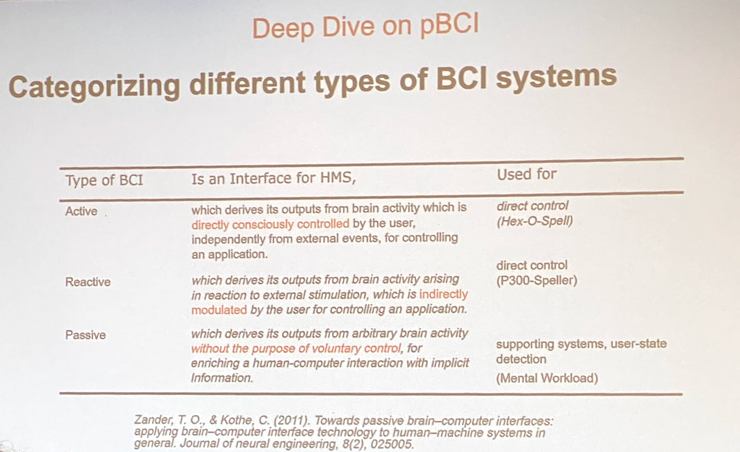
Some of the most exciting approaches to sketching the neurotech frontier came from governmental research agencies. DARPA aimed for '... an integrated device that does not require surgical implantation, but has the precision to read from and write to 16 independent channels within a 16mm3 volume of neural tissue within 50ms.' [1]. ARIA, a UK agency, aims for a noninvasive device with precision comparable to that of the most advanced invasive systems, Utah arrays, and Neuropixel (chart 2) [2].
Chart 2. Neurotech frontier, Jacques Carolan

While DARPA's vision, at least in one of its scenarios, focuses on non-disabled soldiers, ARIA emphasises civilian healthcare use-case. Partially, this stems from brain disorders being a global challenge for tens of millions of patients. In this paradigm, serving the healthcare market represents a faster avenue to adopting neurotech.
Whether neurotech enhances humans or restores lost functions it is a pivotal technology. Michael Johnson believes that every '... neurotech project is an implicit thesis on 'what kind of thing' a nervous system is, what kind of thing a human is.' [5]. Michael suggests a three steps approach for imaging a 'more human' BCI frontier:
=> Pick your three all-time favourite quotes
=> Journal about what each implies about 'what kind of thing a human is'
=> and 'what sorts of tech would give a human *more* of this' [5].
Another philosophical way of looking at the BCI frontier is a concept of takeoff of subjective conscious experience, or qualia, by Eric Wollberg of Prophetic AI, an ultrasound stimulation device developer. Neurotech frontier is associated with '... a nearly infinite number of qualia with an ever-increasing number of modalities of distribution.' (Chart 3)[22, 2024].
Chart 3. Qualia takeoff through tech paradigms, Eric Wollberg
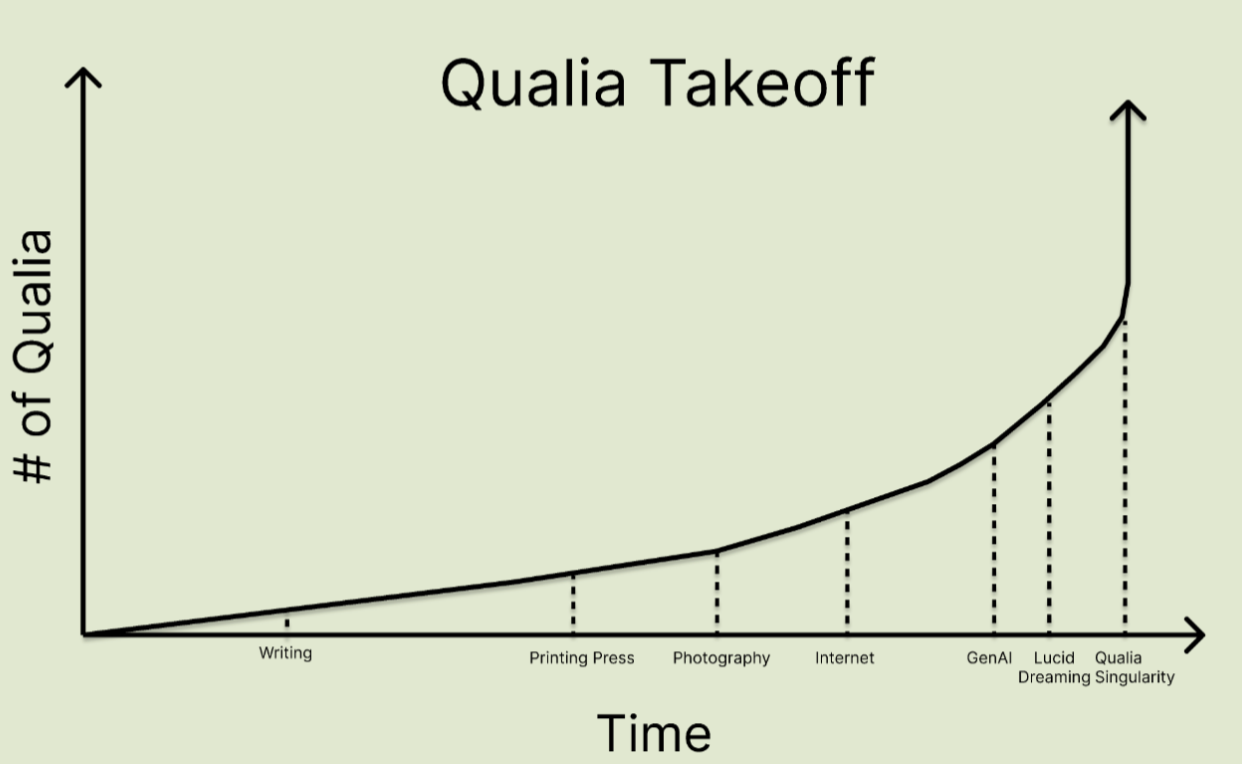
It is not easy to achieve noninvasive writing and reading capabilities from neural tissue. Several approaches have been explored, and various pieces of infrastructure are required to get there.
State of the art
The most advanced fMRI has a spatial resolution of 1mm3 [8] but is not mobile and lacks temporal resolution. More mobile and high spatial/temporal resolution systems are mostly invasive (Neuralink, Blackrock Neurotech). Alternatives are minimally invasive systems - currently, the most advanced ones are built around endovascular electrodes, like Synchron or functional ultrasound, like Forest Neurotech.
Invasive and minimally-invasive
While the concept of endovascular electrodes has been researched since at least the early 1970s [9], functional ultrasound is a nascent technology introduced in 2011 [10]. One of Forest Neurotech's founders, Sumner Norman, started to experiment with fUS in 2017, grew in confidence in it in around 2020, and later, after Butterfly Network introduced a silicon-based ultrasound chip with 9K channels [11], launched a company in 2023 [12]. So it took circa twelve years between the technology being introduced and the moment when the team felt it was the right time to launch a neurotech company built around it.
Interestingly, a pattern of replying technologies developed for other fields is present in neurotech. Cardiac pacemakers are a founding component of modern brain stimulation; stents, borrowed from cardiology, are used for endovascular electrode delivery by Synchron, and now ultrasound systems developed for point-of-care assessments are reapplied in neurotech.
Functional ultrasound system, developed by Forest Neurotech, promises, among other things: a) minimally-invasiveness: requires a smaller craniotomy, acts as a skull replacement, and is epidural, i.e. placed on the dura, with no electrodes running down through the dura and into the brain parenchyma itself, b) flexibility - could be adjusted to various targets as neural circuits move over time, are different from person to person, and are specific to each indication; c) signal reconstruction from across the brain, ca. 12 cm deep. Among the challenges were miniaturisation, the need to generate enough pressure to penetrate brain tissue, and generate fast waves without breaking them [12].
In addition to those above endovascular and fUS-based BCIs, a few emerging approaches for modulating neurons were mentioned [2], including biochemically functionalised electrodes for targeting specific cell types [14], 'living electrodes' [15], activity-dependent gene therapy [16].
Sam Hosovsky, the founder of uCat, covered the frequently overlooked theme of connecting BCIs with virtual worlds. Sam argues that expressivity matters most of all, and without smooth integration between BCIs and virtual words, BCI users can hardly express themselves fully [30].
Noninvasive
Minimally invasive or invasive systems are considered the state of the art [13]. On the fields of Esmeralda and while talking to venture capitalists (VCs) in San Francisco, I sensed scepticism towards noninvasive modalities, e.g., EEG, fNIRS, and others. However, I'd be open-minded. Even as it is, EEG-powered systems could predict bluffs in board games better than humans [6], or in combination with data from other biosensors, they may be helpful for emotion recognition.
Among noninvasive modalities, fMRI seems to be the most useful now, partially due to the large and standardised dataset [12]; EEG lacks standardisation, and it is a challenge that may soon be addressed by Apple releasing EEG-enabled AirPods and collecting immense volumes of data in a standardised format. On top of that, both noninvasive and invasive modalities need more diverse data, as most of the collection took place in laboratory setups, not during naturalistic behaviour [12].
Delivering sensors to a target remains a challenge for noninvasive modalities. For example, MEG is not mobile, similar to fMRI, and requires magnetic shielding, and dry EEG electrodes do not seem to deliver their promise. While easier to attach compared to wet electrodes, they had to be pressed with more force. Therefore, wearing dry electrodes for more than 45 minutes is challenging, and they are prone to producing more artefacts from friction against the skin (minimised if a gel is applied) [6].
Despite challenges, Thorsten Zander of Zander Labs and Ore Ogundipe of NeuroFusion made me more optimistic about the noninvasive side. Data standardisation may be achieved when big names like Apple launch their products, electrodes constantly improve, and AI algorithms used for decoding evolve.
While Apple usually goes full-stack, NeuroFusion embarks on an alternative way of standardising EEG by building a foundation model that could work with many diverse devices (see an illustration of this diversity in chart 4) [29].
Chart 4. Variability of the EEG headsets, Ore Ogundipe
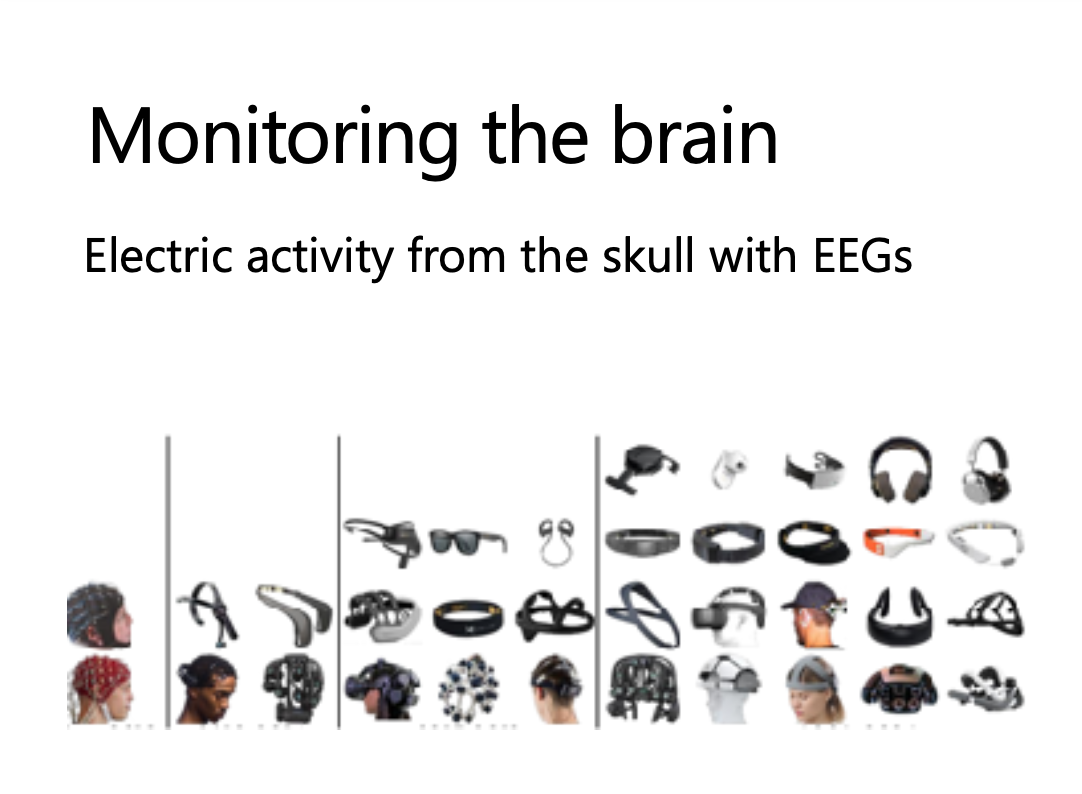
In addition to data, several other pieces should be implemented to achieve the neurotech frontier. These include a better understanding of the brain, available labs, proper financing, and regulation.
Infrastructure
Whole brain emulation
Whole brain emulation (WBE) is a critical component of the neurotech frontier. It is a tool to understand the brain better and enable advanced BCIs. WBE is also required for biohybrid BCIs, as it helps to understand how to introduce external cells into the living brain. WBE also contributes to AI research by enabling brain-inspired aligned artificial general intelligence (AGI) and preconfigured models at the mechanistic circuit levels for higher efficiency [16, 20].
Current emulation approaches are limited by the need to slice the human brain and the capabilities of the computer vision algorithms required to analyse the tissue. At the current technological level, emulating one mouse connectome will take seventeen years and cost around $22B (chart 5) [16].
Chart 5. Time & cost for one mouse connectome, Andrew Payne

Recent technological breakthroughs have allowed better and faster imaging [16]. The most important ones are cellular barcoding, biomolecules delivered to cells to encode their identities [17], and multiplexed expansion microscopy, which allows granularity enough to see synapses [18]. Data at the single-neuron level will be required to build a lofi functional model, and data at the synapse level will be needed for a hifi structural model (chart 6) [20].
Chart 6. Whole brain emulation models by data granularity and capacity, Catalin Mitelut
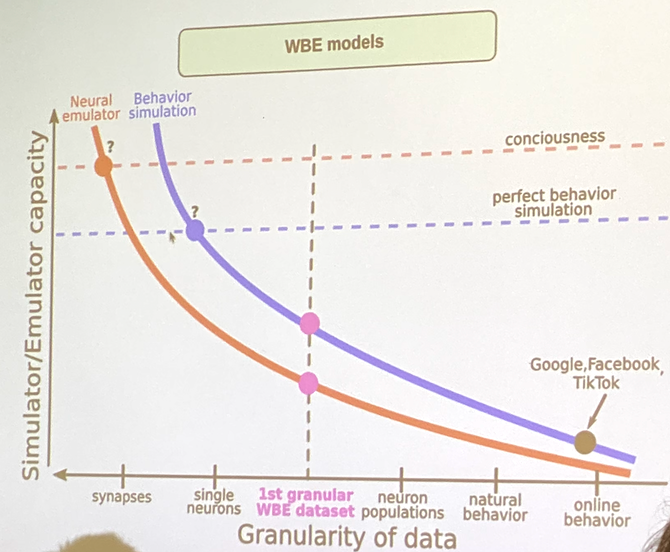
E11 Bio is working on precision circuit mapping using these technologies and expects to produce a mouse brain connectome between 2027 and 2030 [16]. Some believe a neural human brain simulation will be possible sometime between 2020 and 2040, Chart 7 [24].
Chart 7. Frontier technologies emergence as a function of time and computing, Juan Benet
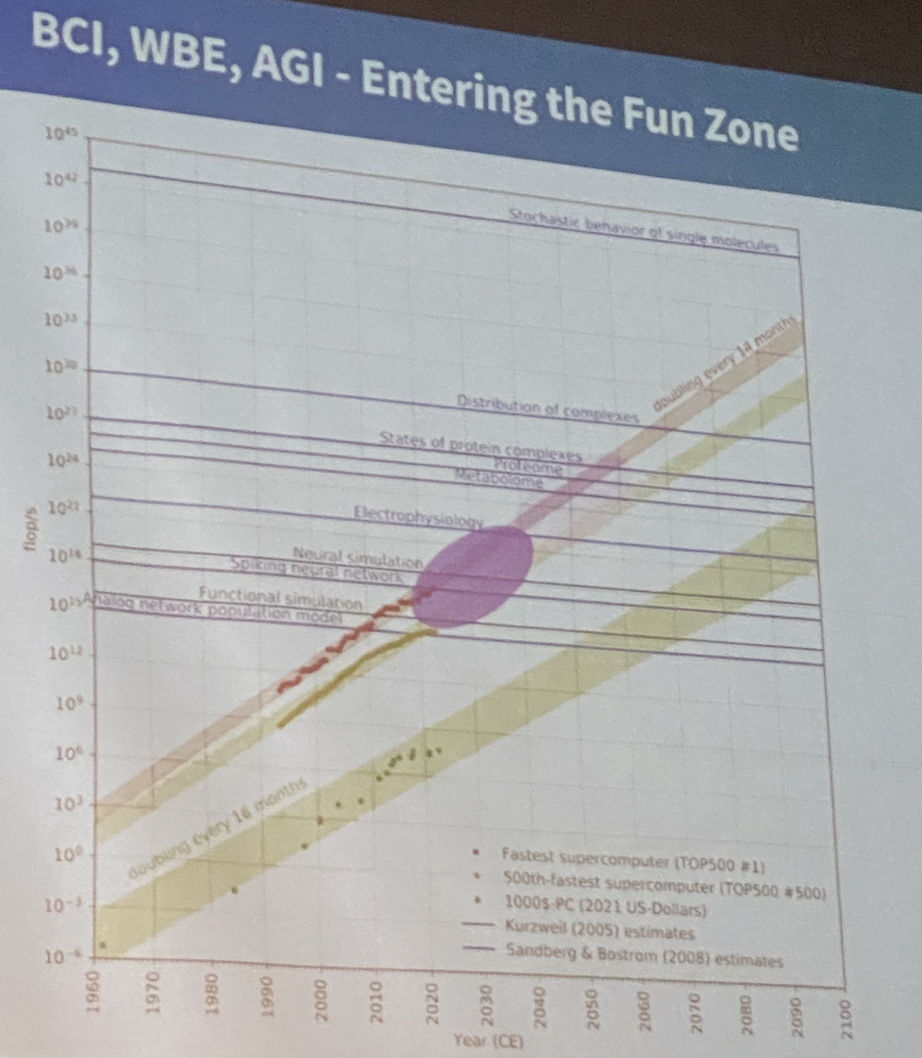
Organoids
Human brain organoids [19] are another technology likely required for developing advanced BCIs. Organoids are a window into the primordial system and the early stages of brain development. The neocortex is formed in week 52 before the brain receives external signals (chart 8) [21].
Chart 8. Human brain development process, Tal Sharf

Tal Sharf and colleagues demonstrated spikes in organoids, functional connectivity, and preconfigured brain states. Organoids are developed via roughly the following process: fibroblasts > iPSC > neuronal induction > self-organisation, forming cellular scaffolding to support neural networks. CMOS detectors with 26.4K electrodes on a 4mm chip and Neuropixels are used to read from organoids [21, 2022].
Developing novel tools to interact with organoids selectively with specific cell types is an important process. Among the modalities, in addition to those mentioned above, are calcium imaging and optogenetics [21].
In addition to providing insights into the brain, organoids may contribute to [21]: 1) developing better artificial neural networks via extracting architectures from the brain. It seems that organoids learn faster than artificial neural networks, as they have some amount of pre-configuration encoded in the genome for efficient computing; 2) therapies by replacing damaged tissue.
Labs
Getting to the neurotech frontier is only possible with offline infrastructure. The media covers surgery-related infrastructure like neurosurgery operating theatres or cath labs well, but laboratories, where research happens, must be appreciated more.
In the ideal world, every neurotech developer has its own lab. Meanwhile, under constraints, one has to outsource and use someone else's infrastructure. Claire Short and the session participants offered some intuition around that, including [7]:
• Instead of building your own lab, find collaborators in the academia/industry who do adjacent research and whose primary or secondary objectives you could contribute to;
• Examples of compatibility with collaborators might be – someone used a 32-channel headset, but you could run their experiments on various types of hardware, or someone run experiments in the lab settings, while you could help them to run it in patients/users' houses or offices;
• Building relationships early/in advance to avoid 'pitching the right group of collaborators at the wrong time';
• While an in-house lab allows for faster iterations, using an external lab and support (from collaborators or CROs) has merits. For instance, they could provide higher rigour/scrutiny compared to what a fast-paced startup could provide in-house; also, using a partner or CRO implies a higher degree of interoperability/standardisation and, in a sense, motivates a startup to develop better processes.
Communities
Research and translation do not happen in isolation; communities are paramount, especially at the early stage, when the field, say neurotech, does not exist and is at the pre-paradigmatic stage, i.e. there are various theories of how the brain works but non is predictive enough [5].
Edge Esmeralda, who co-organised LabWeek, is a fantastic community where folks from various fields meet.
On the neurotech side, I'd mention Neurotech at Berkley, one of the oldest student neurotech communities, and a few more recent ones. Neurotech X, a globally distributed network, Neurotech Society at Imperial College London, the first student-led neurotech society in the United Kingdom, and Silicon Valley Neurotech Forum, whose inaugural meetup occurred this June (chart 9).
Chart 9. Inaugural Silicon Valley Neurotech Forum, June 12th, 2024

Funding
Luckily, the funding required to make neurotech happen extends beyond the well-known venture capital route. Non-profit, philanthropy-funded focused research organisations (FROs) are a recent concept [23]. Two of them, for example, were recently formed to support Forest Neurotech's quest for a BCI [3] and E11 Bio's WBE roadmap [4].
FROs aim to bring the base, determination, and capabilities associated with tech startups to activities typically undertaken in research labs (projects like Human Genome, Hubble Telescope, etc). FROs offer a tighter integration compared to a loose collaboration between several 2-3 people research teams required to move the needle of a large project. It also provides appropriate financing, similar in size to a tech startup scale ($30-50M), but delivered faster, without the slow ramp-up of consecutive investing rounds. These organisations match ideas, founders, and funders [25].
FROs focus on experimentation problems rather than theoretical bottlenecks, where the challenge is associated with, for example, achieving data collection via brain mapping at scale.
Typically, within 5-7 years after the launch, a FRO dissolves, while its work's results move across one or several transition pathways, including public good, in the form of a tool, a dataset, technology licensing, or for-profit spin-out.
FROs are exciting, as they allow us to embark on 'not-incentivised, but buildable' projects that otherwise would not have been possible. I'm very excited about the approach of building 'doable' things. In Michael Johnson's words, the neurotech '... is unlikely to fit our stereotypes of neurotech because our stereotypes are based on dated stories about the brain that have produced very little' [5]. If we focus on incentivised building, we may be trapped by stereotypes and reproduce dated stories instead of opening new horizons.
From a VC perspective, I'm curious about to what extent the concept scales beyond Convergent Research's plans to spin a couple of FROs a year [25] and achieves the scale and impact of Y Combinator, whose ability to enable hundreds of early-stage startups annually structurally changes the VC land and overall tech landscape.
Another funding option is various advanced research project agencies (ARPAs), such as DARPA, the most well-known in the US, and ARIA, which was recently established in the UK. ARIA allocates ca. £50M for a 3 to 5-year programme and considers smaller, earlier-stage projects than FROs. Based on a two-page pitch, opportunity seeds are smaller explorations with budgets of £10-500K.
While the formation process for FROs starts from a 300-long ideas list and is done collaboratively with potential funders, philanthropists and foundations [25], ARIA is funded by the UK government and operates within seven opportunity spaces, including neurotech [2].
The contractual work for industrial partners should supplement philanthropy and government grants, believes Angelo Liao, a co-founder of Forge, an ERP for deep tech in climate, defence, and bio. Angelo also suggests actively partnering with academic institutions to share the burden of funding the research part of a neurotech startup [26].
Laws & regulation
Alex Feerst reminded us about the 'law of the horse' and the argument '... against the notion of defining cyberlaw as a unique section of legal studies and litigation…' [27] that might be applied to neurotech. Alex offered a three-step approach to deciding when new regulation for an emergent field, such as neurotech, is required [28]:
1. Are there existing laws that at least partially regulate parts of the new technology's value/supply chain? E.g. manufacturing and distribution, IP, and some contractual preferences;
2. Identify items unique to this new technology, say BCIs, and ensure they are not an intensification of existing tech;
3. Identify items that will be affected after the wide adoption of this new tech, e.g., BCIs. For instance, BCIs are applied in the legal system for evidence collection, interrogation, etc. What should be done here?
Being careful when introducing new laws is important because bad actors have the opportunity to abuse them and the long process of amending them. For example, BIPA Illinois was amended after 15 years as bad actors weaponised too much. Snap was sued for collecting facial pictures for a lens that looked like a biometric collection, but it was not biometric data collection.
BCIs will likely be regulated by the FDA. Separately from regulation, Alex covered the ownership aspect of BCIs. Alex believes that '... since their critical nature, BCIs will likely be owned, unlike most subscription-based modern tech.' I'd subscribe to that, and an addition to ownership might be a robust open-source framework/ecosystem allowing the replacement and maintenance of even third-party/corporate-owned devices freely.
Conclusion & contacts
Things look bright for neurotech. It seems like the communities are thriving, field building work is active, alternative ways of funding are emerging, and infrastructure is under development. There are technological, cultural and other challenges, but when all the items from above are in place, they will be solved.
Contact me via p@e184.com if you are building components/products/platforms/fields in neuro, researching it, or funding it. I'd love to talk.
📬📬📬 Subscribe for notes like this and monthly updates on neurotech and neurotech investment/commercialisation activity.
***
[1] https://www.darpa.mil/program/next-generation-nonsurgical-neurotechnology
[2] Jacques Carolan, 'Precision neurotechnologies: interfacing with the human brain at scale', a presentation at LabWeek 2024
[3] https://forestneurotech.org/
[4] https://e11.bio/about
[5] Michael Johnson, 'Neurotech as Philosophy About What We Are: 5 Models', a presentation at LabWeek 2024. and http://opentheory.net/MJ_EE_June2024.pdf (2024)
[6] Thorsten O. Zander, 'Deep dive on passive BCIs', a presentation at LabWeek 2024
[7] Claire Short, 'Starting a BCI/AI Lab', a salon at LabWeek 2024
[8] https://www.biorxiv.org/content/10.1101/2023.05.13.540663v1
[9] https://www.nature.com/articles/s41598-018-26457-7
[10] https://www.bu.edu/neurophotonics/research/fus/#:~:text=Power%20Doppler%2Dbased%20functional%20ultrasound,resolution%20with%20%3E15%20mm%20penetration.
[11] https://www.butterflynetwork.com/press-releases/merger-longview
[12] Sumner Norman, 'Neurotechnology: Past, Present, and Future', a presentation at LabWeek 2024
[13] https://www.nature.com/articles/d41586-023-02546-0?ref=peterzhegin.com
[14] https://www.science.org/doi/10.1126/sciadv.adk1050
[15] https://www.science.org/doi/10.1126/sciadv.aay5347
[16] Andrew Payne, 'The path towards mammalian whole-brain circuit mapping', a presentation at LabWeek 2024
[17] https://www.nature.com/articles/s41592-018-0185-x
[18] https://pubmed.ncbi.nlm.nih.gov/31326595/
[19] https://www.ncbi.nlm.nih.gov/pmc/articles/PMC10420018/
[20] Catalin Mitelut, 'Re-framing the experimental, computational and theoretical challenges in Whole-Brain-Emulation from an agency neuroscience perspective', a presentation at LabWeek 2024
[21] Tal Sharf, 'A window into the brain’s primordial operating system', a presentation at LabWeek 2024 and https://www.nature.com/articles/s41467-022-32115-4 (2022), https://www.biorxiv.org/content/10.1101/2023.12.29.573646v1 (2023)
[22] Eric Wollberg, 'Qualia Takeoff in The Age of Spiritual Machines', a salon at LabWeek 2024 and https://www.blog.propheticai.co/blog/cac5ipk3midzzjy8vnyp8zh2umyzup (2024)
[23] Day one project. Focused Research Organizations to Accelerate Science, Technology, and Medicine. Samuel G. Rodriques Adam H. Marblestone. September 2020
[24] Juan Benet, talk at the Opening Reception at LabWeek 2024
[25] Anastasia Gamick, 'Convergent Research', a presentation at LabWeek 2024
[26] Angelo Liao, a chat at the fields of Edge Esmeralda
[27] https://en.wikipedia.org/wiki/Law_of_the_Horse#:~:text=Law%20of%20the%20Horse%20was,presentation%20by%20Judge%20Frank%20H.
[28] Alex Feerst, 'Legal Developments Related to BCI', a presentation at LabWeek 2024
[29] Ore Ogundipe, 'Decoding the Brain: Understanding Brain Activity with EEGs', a presentation at LabWeek 2024
[30] Sam Hosovsky, 'Building The Matrix: BCI-XR-AI', a presentation at LabWeek 2024